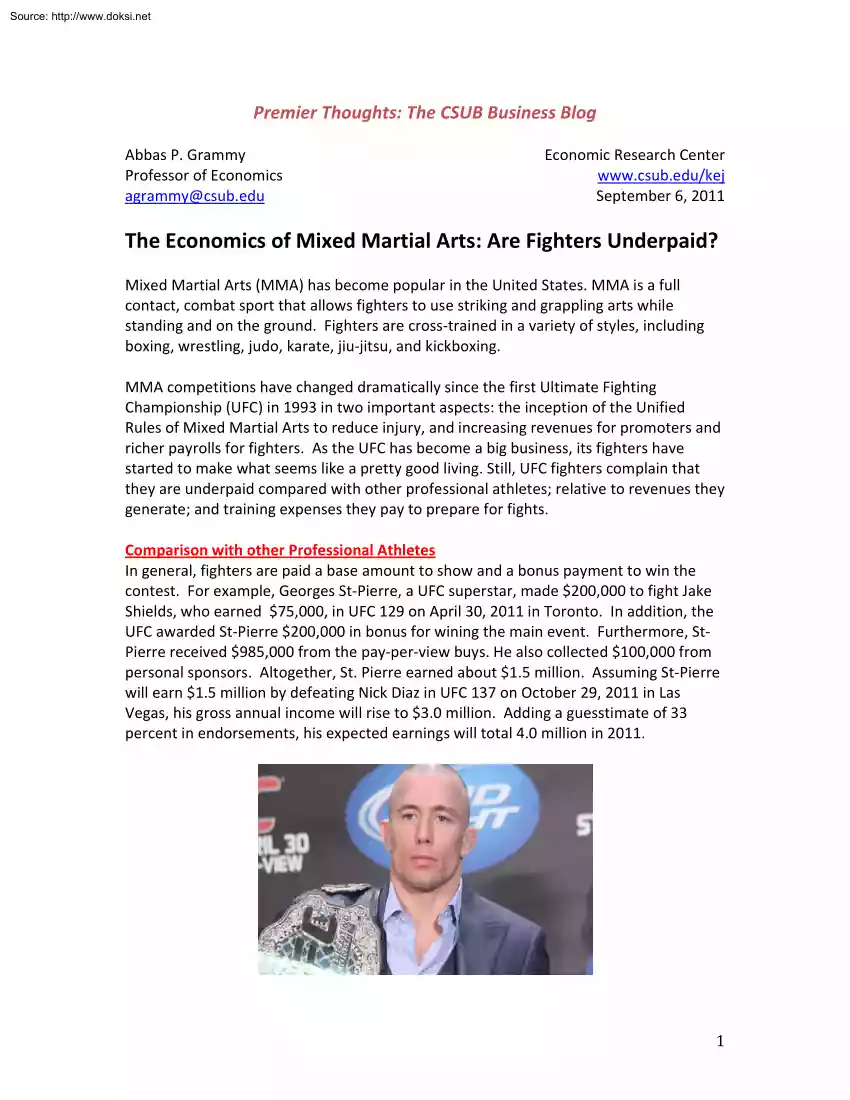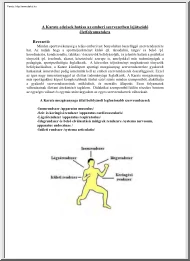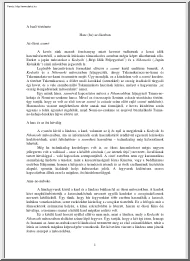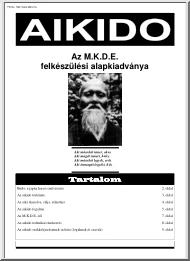Datasheet
Year, pagecount:2011, 5 page(s)
Language:English
Downloads:3
Uploaded:June 24, 2019
Size:713 KB
Institution:
-
Comments:
Economic Research Center
Attachment:-
Download in PDF:Please log in!
Comments
No comments yet. You can be the first!Most popular documents in this category
Content extract
Source: http://www.doksinet Premier Thoughts: The CSUB Business Blog Abbas P. Grammy Professor of Economics agrammy@csub.edu Economic Research Center www.csubedu/kej September 6, 2011 The Economics of Mixed Martial Arts: Are Fighters Underpaid? Mixed Martial Arts (MMA) has become popular in the United States. MMA is a full contact, combat sport that allows fighters to use striking and grappling arts while standing and on the ground. Fighters are cross-trained in a variety of styles, including boxing, wrestling, judo, karate, jiu-jitsu, and kickboxing. MMA competitions have changed dramatically since the first Ultimate Fighting Championship (UFC) in 1993 in two important aspects: the inception of the Unified Rules of Mixed Martial Arts to reduce injury, and increasing revenues for promoters and richer payrolls for fighters. As the UFC has become a big business, its fighters have started to make what seems like a pretty good living. Still, UFC fighters complain that they are underpaid
compared with other professional athletes; relative to revenues they generate; and training expenses they pay to prepare for fights. Comparison with other Professional Athletes In general, fighters are paid a base amount to show and a bonus payment to win the contest. For example, Georges St-Pierre, a UFC superstar, made $200,000 to fight Jake Shields, who earned $75,000, in UFC 129 on April 30, 2011 in Toronto. In addition, the UFC awarded St-Pierre $200,000 in bonus for wining the main event. Furthermore, StPierre received $985,000 from the pay-per-view buys He also collected $100,000 from personal sponsors. Altogether, St Pierre earned about $15 million Assuming St-Pierre will earn $1.5 million by defeating Nick Diaz in UFC 137 on October 29, 2011 in Las Vegas, his gross annual income will rise to $3.0 million Adding a guesstimate of 33 percent in endorsements, his expected earnings will total 4.0 million in 2011 1 Source: http://www.doksinet However, St-Pierre makes
considerably less than his comparable peers in professional sports. The Forbes Magazine, reporting on annual earnings of the world’s richest athletes for the period of May 2010 to May 2011, places Tiger Woods (PGA) at $75 million, Koby Bryant (NBA) $53 million; Roger Federer (ATP) $47 million; David Beckham (MLS) $40 million; Manny Pacquiao (boxing) $40 million; Alex Rodriguez (MLB) $35 million; Tom Brady (NFL) $31 million; and Roberto Luongo (NHL) $10 million. Highest Earning Professional Athletes $80,010,000 $60,010,000 $40,010,000 $20,010,000 $10,000 On average, UFC fighters make considerably less than other professional athletes. In 2010, the UFC paid its 265 fighters $26.8 million But, the payroll distribution was highly skewed with a mean of $101,100 and standard deviation of $149,600. Most interesting, the payroll distribution had a mode of only $8,000 and a median of just $45,000. While 14 percent of the fighters earned more than $200,000, 33 percent made less than $20,000.
The average earnings of UFC fighters fall short of those of other professional sports. The NBA pays the largest average salary ($60 million) followed by MLB ($3.3 million), NHL ($24 million), NFL ($19 million), PGA ($10 million), ATP ($260,000), and MLS ($118,000). $6,010,000 Average Annual Income in Professional Sports $5,010,000 $4,010,000 $3,010,000 $2,010,000 $1,010,000 $10,000 NBA MLB NHL NFL PGA ATP MLS UFC 2 Source: http://www.doksinet Generating Revenues for the League The UFC is becoming a major sport league with 16 pay-per-view events and 10 television events scheduled in 2011. The league earns millions of dollars in revenues from various sources, including ticket sales, pay-per-view buys, and television contracts. So far, UFC 129 has been the largest MMA event held in North America. It entertained 55,724 spectators at ticket prices ranging from $50 to $800, thus generating $12.1 million in ticket sales. In addition, the event sold 850,000 pay-per-view rights
at an average price of $49.95, hence generating $425 million Adding these two figures, the event’s revenue totaled $54.6 million UFC 129 had a reported payroll of $1,840,000, which consisted of three parts: $326,000 in base compensation to 24 fighters; $529,000 in bonus payment to 13 fighters; and the remaining $985,000 in pay-per-view share to St-Pierre. The ratio of fighters’ payroll to event’s revenue is 3.4 percent, indicating the event’s 24 fighters collectively received 34¢ from each $1,000 of the revenue. The ratio drops to 0.8 percent if St-Pierre is excluded from the payroll This percentage implies that the event’s remaining 23 fighters collectively received 8¢ from each $1,000 of the revenue. Paying Training Expenses In addition to being underpaid, UFC fighters must cover their own training expenses. Unlike boxing, UFC fighters must allocate a large percentage of their income to pay for training expenses. It is customary for a top fighter to organize an
eight-week training camp to prepare for an upcoming bout. How much does a top fighter earning $250,000 [like Randy Couture (a three-time former heavyweight champion and two-time former light-heavyweight champion), who also fought in UFC 129] actually take home at the end of the night? The answer is rather surprising: less than 50 percent! Jonathan Snowden, talking with a number of fighters, managers, and industry figures provides a list of expenses such a top fighter must cover: 3 Source: http://www.doksinet Manager/Agent: $25,000 High-level coaches: $15,000 Dietitian: $7,500 Travel: $10,000 Housing: $10,000 Additional training partners (five): $3,500 Rental cars: $2,400 Food for training partners: $2,400 Flights for wife and kids to visit once: $1,500 Food: $2,000 Supplements: $1,000 Gear: $100 Rehab sessions: $600 Massage: $225 Gas: $800 Taxes (18%): $45,000 Total Expense: $127,025 (51.8%) Take Home Pay: $122,975 (49.2%)
These figures reveal interesting facts: a top fighter must invest much money in getting ready for a bout, and a fighter coming from the undercard to challenge a UFC champion needs a large bank account or a generous sponsor to become competitive. At the end of the night, he goes home with a split paycheck and cuts and bruises. Sources: http://www.therichestorg/sports/forbes-highest-paid-athletes/ http://en.wikipediaorg/wiki/UFC 129 Fox, Jeff, “2010 Year in Review: UFC Fighter Salaries,” MMA Manifesto, 29 December 2010 http://www.mma-manifestocom/ufc-fighter-salary-database/salary-main/2010-year-in-review-ufcsalarieshtml Fox, Jeff, “GSP: The 2.5 Million Dollar Man?” MMA Manifesto, 07 May 2011 http://www.mma-manifestocom/ufc-fighter-salary-database/salary-main/gsp-the-three-million-dollarmanhtml Snowden, Jonathan, “The Economics Of MMA: How Much Does It Cost To Be A Fighter?” MMA Nation, August 18, 2011 4 Source: http://www.doksinet
http://mma.sbnationcom/2011/8/18/2161891/the-economics-of-mma-how-much-does-it-cost-to-be-afighter 5
compared with other professional athletes; relative to revenues they generate; and training expenses they pay to prepare for fights. Comparison with other Professional Athletes In general, fighters are paid a base amount to show and a bonus payment to win the contest. For example, Georges St-Pierre, a UFC superstar, made $200,000 to fight Jake Shields, who earned $75,000, in UFC 129 on April 30, 2011 in Toronto. In addition, the UFC awarded St-Pierre $200,000 in bonus for wining the main event. Furthermore, StPierre received $985,000 from the pay-per-view buys He also collected $100,000 from personal sponsors. Altogether, St Pierre earned about $15 million Assuming St-Pierre will earn $1.5 million by defeating Nick Diaz in UFC 137 on October 29, 2011 in Las Vegas, his gross annual income will rise to $3.0 million Adding a guesstimate of 33 percent in endorsements, his expected earnings will total 4.0 million in 2011 1 Source: http://www.doksinet However, St-Pierre makes
considerably less than his comparable peers in professional sports. The Forbes Magazine, reporting on annual earnings of the world’s richest athletes for the period of May 2010 to May 2011, places Tiger Woods (PGA) at $75 million, Koby Bryant (NBA) $53 million; Roger Federer (ATP) $47 million; David Beckham (MLS) $40 million; Manny Pacquiao (boxing) $40 million; Alex Rodriguez (MLB) $35 million; Tom Brady (NFL) $31 million; and Roberto Luongo (NHL) $10 million. Highest Earning Professional Athletes $80,010,000 $60,010,000 $40,010,000 $20,010,000 $10,000 On average, UFC fighters make considerably less than other professional athletes. In 2010, the UFC paid its 265 fighters $26.8 million But, the payroll distribution was highly skewed with a mean of $101,100 and standard deviation of $149,600. Most interesting, the payroll distribution had a mode of only $8,000 and a median of just $45,000. While 14 percent of the fighters earned more than $200,000, 33 percent made less than $20,000.
The average earnings of UFC fighters fall short of those of other professional sports. The NBA pays the largest average salary ($60 million) followed by MLB ($3.3 million), NHL ($24 million), NFL ($19 million), PGA ($10 million), ATP ($260,000), and MLS ($118,000). $6,010,000 Average Annual Income in Professional Sports $5,010,000 $4,010,000 $3,010,000 $2,010,000 $1,010,000 $10,000 NBA MLB NHL NFL PGA ATP MLS UFC 2 Source: http://www.doksinet Generating Revenues for the League The UFC is becoming a major sport league with 16 pay-per-view events and 10 television events scheduled in 2011. The league earns millions of dollars in revenues from various sources, including ticket sales, pay-per-view buys, and television contracts. So far, UFC 129 has been the largest MMA event held in North America. It entertained 55,724 spectators at ticket prices ranging from $50 to $800, thus generating $12.1 million in ticket sales. In addition, the event sold 850,000 pay-per-view rights
at an average price of $49.95, hence generating $425 million Adding these two figures, the event’s revenue totaled $54.6 million UFC 129 had a reported payroll of $1,840,000, which consisted of three parts: $326,000 in base compensation to 24 fighters; $529,000 in bonus payment to 13 fighters; and the remaining $985,000 in pay-per-view share to St-Pierre. The ratio of fighters’ payroll to event’s revenue is 3.4 percent, indicating the event’s 24 fighters collectively received 34¢ from each $1,000 of the revenue. The ratio drops to 0.8 percent if St-Pierre is excluded from the payroll This percentage implies that the event’s remaining 23 fighters collectively received 8¢ from each $1,000 of the revenue. Paying Training Expenses In addition to being underpaid, UFC fighters must cover their own training expenses. Unlike boxing, UFC fighters must allocate a large percentage of their income to pay for training expenses. It is customary for a top fighter to organize an
eight-week training camp to prepare for an upcoming bout. How much does a top fighter earning $250,000 [like Randy Couture (a three-time former heavyweight champion and two-time former light-heavyweight champion), who also fought in UFC 129] actually take home at the end of the night? The answer is rather surprising: less than 50 percent! Jonathan Snowden, talking with a number of fighters, managers, and industry figures provides a list of expenses such a top fighter must cover: 3 Source: http://www.doksinet Manager/Agent: $25,000 High-level coaches: $15,000 Dietitian: $7,500 Travel: $10,000 Housing: $10,000 Additional training partners (five): $3,500 Rental cars: $2,400 Food for training partners: $2,400 Flights for wife and kids to visit once: $1,500 Food: $2,000 Supplements: $1,000 Gear: $100 Rehab sessions: $600 Massage: $225 Gas: $800 Taxes (18%): $45,000 Total Expense: $127,025 (51.8%) Take Home Pay: $122,975 (49.2%)
These figures reveal interesting facts: a top fighter must invest much money in getting ready for a bout, and a fighter coming from the undercard to challenge a UFC champion needs a large bank account or a generous sponsor to become competitive. At the end of the night, he goes home with a split paycheck and cuts and bruises. Sources: http://www.therichestorg/sports/forbes-highest-paid-athletes/ http://en.wikipediaorg/wiki/UFC 129 Fox, Jeff, “2010 Year in Review: UFC Fighter Salaries,” MMA Manifesto, 29 December 2010 http://www.mma-manifestocom/ufc-fighter-salary-database/salary-main/2010-year-in-review-ufcsalarieshtml Fox, Jeff, “GSP: The 2.5 Million Dollar Man?” MMA Manifesto, 07 May 2011 http://www.mma-manifestocom/ufc-fighter-salary-database/salary-main/gsp-the-three-million-dollarmanhtml Snowden, Jonathan, “The Economics Of MMA: How Much Does It Cost To Be A Fighter?” MMA Nation, August 18, 2011 4 Source: http://www.doksinet
http://mma.sbnationcom/2011/8/18/2161891/the-economics-of-mma-how-much-does-it-cost-to-be-afighter 5





 When reading, most of us just let a story wash over us, getting lost in the world of the book rather than paying attention to the individual elements of the plot or writing. However, in English class, our teachers ask us to look at the mechanics of the writing.
When reading, most of us just let a story wash over us, getting lost in the world of the book rather than paying attention to the individual elements of the plot or writing. However, in English class, our teachers ask us to look at the mechanics of the writing.